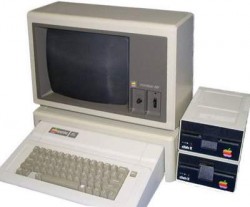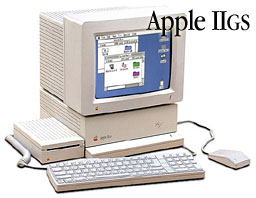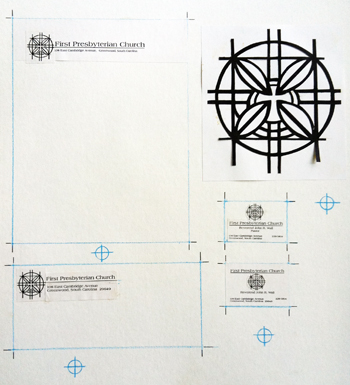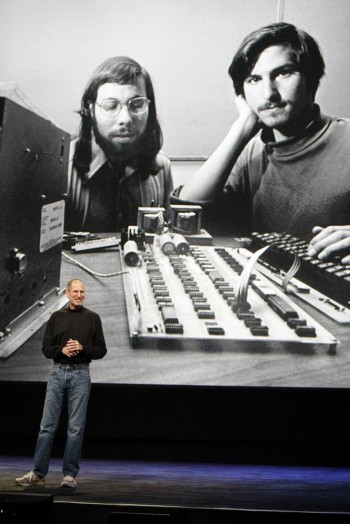This week, I’d like to take a moment to remember Co-Founder Steve Jobs, and to thank Steve Wozniak and everyone else at Apple, Inc. for sculpting my career and my life by envisioning and creating the technology to make computerized graphic design possible. Above photo from the Times-Picayune – NOLA.com
A is for Apple
I remember the very first time I saw one…
It was fifth grade, and it was so big it had to be wheeled in on a media cart. Our school only had one of these beauties, so we had to share it. Yes, it was the Apple II. As children, we were drawn to this curiosity like moths to a flame. I fell in love immediately – and somehow I knew, even then, that this piece of hardware would someday change my life.
Little did I know just how much!
Throughout school, we had Apple Labs, in which three or four students would crowd around one computer and marvel at all the cool games – yes, even the math games. (Yuck!)
 By high school, we had an Apple IIGS in our home. I didn’t realize how much Dad paid for it until I did a little research here. Turns out it was a whopping $999! Plus, we had a 3.5” floppy drive (an extra $399) and a color monitor (another $499). Adjusted for inflation, that’s somewhere around $3,500! Up until about four years ago it was still stashed in a closet along with some old games. Now get this: it still chimed on like a champ, despite being out of use for many, MANY years. Back then, my family used the IIGS as a typewriter and for entertainment.
By high school, we had an Apple IIGS in our home. I didn’t realize how much Dad paid for it until I did a little research here. Turns out it was a whopping $999! Plus, we had a 3.5” floppy drive (an extra $399) and a color monitor (another $499). Adjusted for inflation, that’s somewhere around $3,500! Up until about four years ago it was still stashed in a closet along with some old games. Now get this: it still chimed on like a champ, despite being out of use for many, MANY years. Back then, my family used the IIGS as a typewriter and for entertainment.
Apples and Oranges
It wasn’t until college that I started thinking of the computer as a tool. I was so excited that I got to take Commercial Art in my third year. Why? Because use of the Mac Lab was strictly limited to only us lucky Commercial Art students! There were only six machines: three Macintosh IIs and three Macintosh LCs and a printer. (My fourth year, we were blessed with a brand new Quadra.)
In the early 90s, using computers for art was uncharted territory. So, of course, our professors had NO idea how to incorporate the computer into Commercial Art just yet.
I remember the first day of class. Our professor took us to the Mac Lab. There were 20 of us crammed into a tiny room, just a bit bigger than a broom closet, eagerly awaiting our instructions. It was all very exciting – all of us students trembling with excitement, some of us even drooling. We thought, “Our professor is going to teach us to do ART on these machines. Cool!”
So our professor very dramatically performs a Vanna-White-like unveiling, proclaiming, “THIS is the Mac Lab. And THESE are our Macintosh computers!” He then confidently strolls over to one particular Mac, pushes a button on the keyboard and proudly declares, “And THIS is how you turn it on!”
…We were then immediately herded out of the lab and into the classroom across the hall, only to learn the dying art of commercial paste-up!
See, before the Macintosh, all graphic design was done by hand, by pasting graphics on boards with rubber cement. And let me tell you, I was absolutely THE WORST paste-up artist EVER! My paper was always rolling up on the edges because I didn’t apply enough glue, or buckling because I used too much rubber cement. There were  brown globs of glue that I neglected to “erase off” with a rubber cement eraser. Nothing was ever straight on the page. It was always an absolute mess. During reviews, my professor constantly embarrassed me in front of the whole class because my paste-up and lay-out work was so terrible. (Here is a perfect example…the logo is good, but the paste-up and layout is so sloppy. I didn’t understand then, Professor MacTaggart, but I do now!) We only used the Mac’s as a glorified typewriter with funky fonts. I liked the logo creating part but really disliked the production part of the class, so I was going to change my emphasis to Photography or Art History.
brown globs of glue that I neglected to “erase off” with a rubber cement eraser. Nothing was ever straight on the page. It was always an absolute mess. During reviews, my professor constantly embarrassed me in front of the whole class because my paste-up and lay-out work was so terrible. (Here is a perfect example…the logo is good, but the paste-up and layout is so sloppy. I didn’t understand then, Professor MacTaggart, but I do now!) We only used the Mac’s as a glorified typewriter with funky fonts. I liked the logo creating part but really disliked the production part of the class, so I was going to change my emphasis to Photography or Art History.
And WOW, I’m glad that I didn’t!
My last year in college, a part-time teacher was hired to teach Computer Graphics. Yet again, we were stuck in that broom closet, but now with seven computers, and a black and white laser printer. And that’s when I really began to soar. Everything that I couldn’t do as a paste-up Commercial Artist didn’t matter as a Computer Graphic Artist! No more rubber cement, no cutting, and no hours trying to align everything straight – it was all done for me, on one piece of paper. All I had to do was mount one piece of paper on a board and I was done! I knew then this type of design was just the thing for me. Thank you, Apple, Inc.
Apple of My Eye
Today, my home is riddled with computers. I have a Bondi Blue iMac sitting in my garage. In my office, I have a G3, an original G4, and a silver front G4. Right now, I‘m using my MacBook Pro to write this post. I have an iPod and an iPhone. It’s true – I fell in love with Apple in fifth grade and never looked at any other inferior product. My husband and I have always described Apple products as sleek and sexy. I absolutely love Apple, period. Our home is saddened to lose such a visionary.
I‘m using my MacBook Pro to write this post. I have an iPod and an iPhone. It’s true – I fell in love with Apple in fifth grade and never looked at any other inferior product. My husband and I have always described Apple products as sleek and sexy. I absolutely love Apple, period. Our home is saddened to lose such a visionary.
J is for Jobs
 Apple Inc. ran parallel to my life before and after their amazing technology actually dictated my career. Without that pioneering vision Steve Jobs and Steve Wozniak brewed up in a garage two decades prior, I would have ended up an Art Historian or maybe a B&W Landscape Photographer. Left photo from the Times-Picayune – NOLA.com
Apple Inc. ran parallel to my life before and after their amazing technology actually dictated my career. Without that pioneering vision Steve Jobs and Steve Wozniak brewed up in a garage two decades prior, I would have ended up an Art Historian or maybe a B&W Landscape Photographer. Left photo from the Times-Picayune – NOLA.com
Here’s how Steve Jobs described the iPod to Newsweek in October 2006 – and this statement can be applied to most of the Apple line:
“Look at the design of a lot of consumer products – they’re really complicated surfaces. We tried to make something much more holistic and simple. When you first start off trying to solve a problem, the first solutions you come up with are very complex, and most people stop there. But if you keep going, and live with the problem and peel more layers of the onion off, you can oftentimes arrive at some very elegant and simple solutions. Most people just don’t put in the time or energy to get there. We believe that customers are smart, and want objects which are well thought through.”
This is the exact philosophy that makes Apple different. May Apple, Inc. keep Thinking Different and continue to be inspired by the chutzpah and vision that Steve Jobs had for his company and his life’s work – and that is his legacy to us all.
What is your Apple story? We would love to hear it.

Trackbacks/Pingbacks